Imitations of the "Two Victories" coin type of Constantine (c. 318 - 320)
The "Two Victories" reverse illustrated here was common on copper coins of Constantine from 318-320. It was occasionally imitated in the west, and commonly imitated in the Balkans (a term I will use for the region of the former Yugoslavia northward to the border between Austria and Hungary). Since the 1990s many ancient Balkan imitations of Constantine's "Two Victories" reverse type have been coming to market.
Here are two "Two Victories" prototypes:
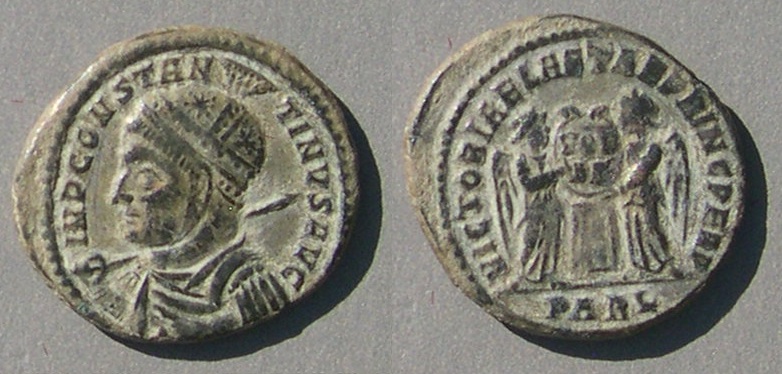 The Constantine "Two Victories" reverse. An official example from the mint of Arles.
The Constantine "Two Victories" reverse. An official example from the mint of Arles.
Two Victories holding a shield inscribed VOT/PR over an altar, VICTORIAE LAETAE PRINC PERP around.
The first example is
19mm and 3.16 grams.
Bust left, with close-fitting helmet, with short high crest at top, spear over far shoulder.
PARL in exergue.
RIC Arles 192, struck 319.
Prototype obverses come in several varieties. They have both with right-facing and left-facing busts, both with and without helmets.
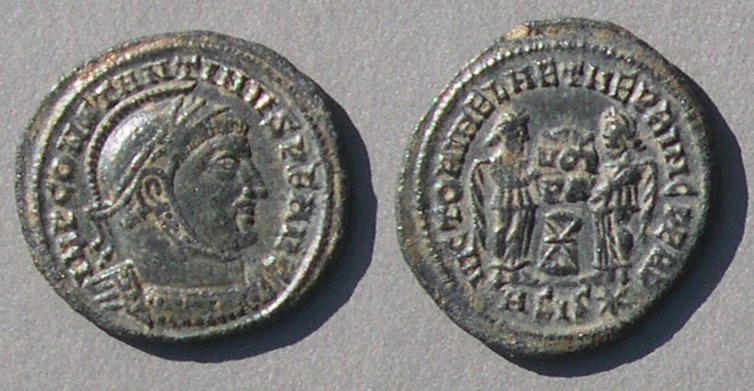 19-18 mm. 2.77 grams.
19-18 mm. 2.77 grams.
The same reverse type, but this time with obverse bust right, again in a close-fitting helmet but this one has a long, low, crest.
ASIS* in exergue.
RIC Siscia 47, struck 318
Imitations. Although this reverse type was issued for Constantine, Crispus, Constantine II, Licinius, and Licinius II, the imitations here seem to be of Constantine. None of the ones here have legends that clearly suggest Crispus, Licinius, or Licinius II, but I have seen one with a clear Crispus legend.
The type (like every other type) was apparently imitated in the western provinces as well as the Balkans. These western imitations range from excellent and deceptive to somewhat crude. In the west the imitations were uncommon. However, in the Balkans they seem to have been quite common.
Five western imitations are illustrated first. Six Balkan imitations follow.
Constantine
Here are five fine imitations that may be western as opposed to "Balkan" imitations. All coins on this page are to scale.
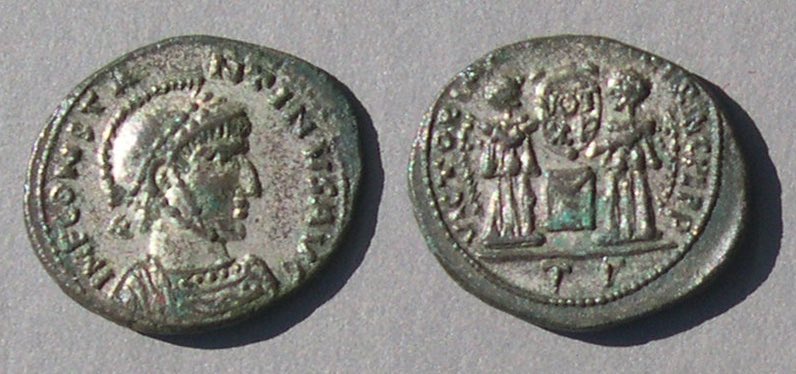 Constantine
Constantine
19-17 mm. 6:00
amazing silvered (!) imitation.
/VICTORIA .... PRINC PERP
Two Victories holding a shield normally inscribed "VOT/PR" but here "VOT/XP". The column floats, unusually, above the ground and below the shield.
/ crude mintmark, maybe T Γ ?
silvered imitation.
Prototype RIC Ticinum 82, 318-319.
I don't recall other examples of originally-silvered imitations.
 Constantine
Constantine
16 mm. 3.07 grams.
Heavy English green patina.
IMP CONSTANTINVS II AVG
VICTORIAE LATAE PRINC PERP 16 mm. 4:30. 3.07 grams
an imitation in fine style, with some legend mistakes.
for example "II AVG" for "PF AVG" on the obverse, and some ill-formed letters on the reverse
/mintmark unclear, perhaps copying "PLN"
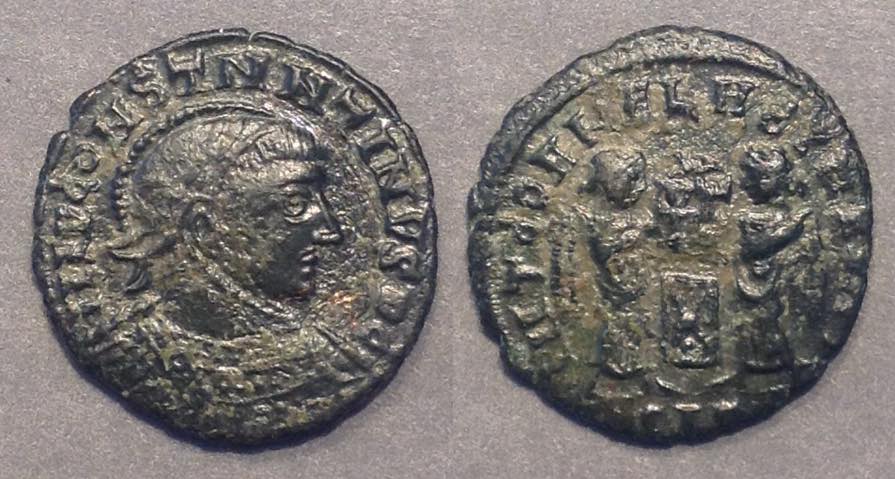 16 mm. 1.63 grams.
16 mm. 1.63 grams.
Letters well-shaped but name misspelled
CONSTNNTINVS
Reverse legend blundered
VITORHE LHET.....
Three letters in exergue, perhaps SIS, but it is not certain.
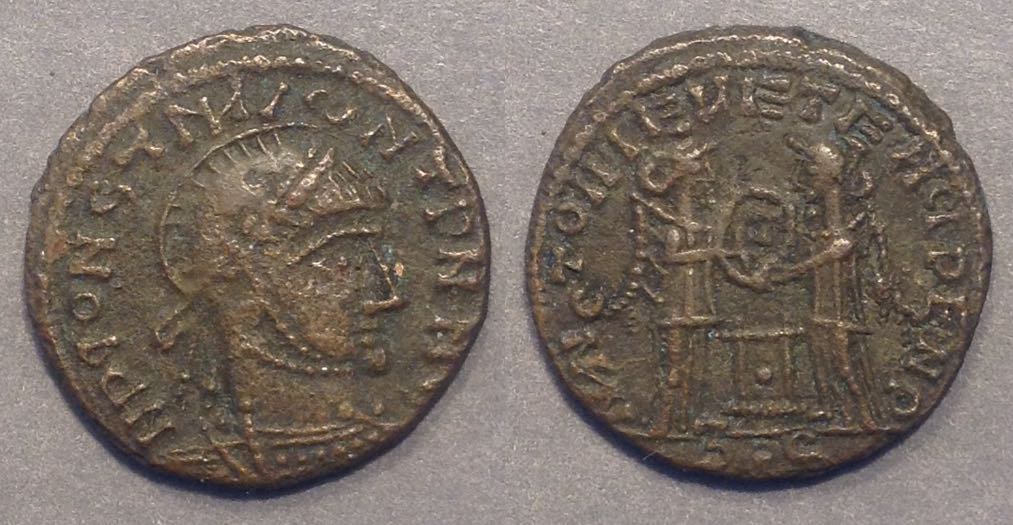 18 mm. 3.60 grams.
18 mm. 3.60 grams.
IIP CONSTNIIONTPNNG (some letters crude)
Crude letters to imitate
VICTORIAE LAET PRINC PERP, rendered somewhat like:
VICTORIE EUETEHCI PENP
TRS
This lettering is much better than most on imitations, with nearly-correct shapes.
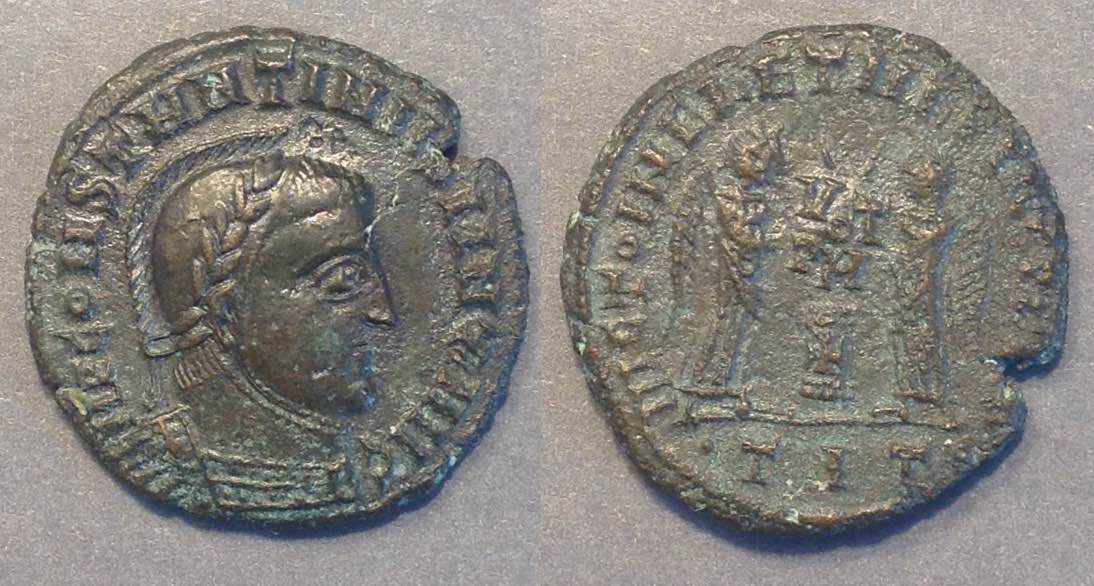
20 mm. Large! 4.05 grams.
This piece is larger than the prototypes!
With some ill-formed letters, it seems to say
IPM CONSTANTINVS MAX AVG.
VICTO INEIETA......
• T I T
Cross, +, on column.
VOT
PR but no shield!
The prototype, next, is from Ticinum, a mint that sometimes has a cross on the column.
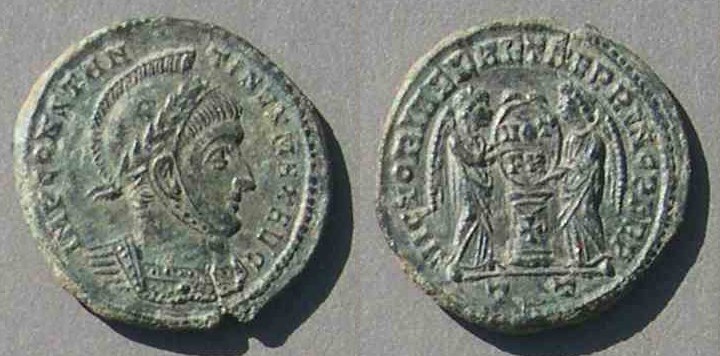 This is an official piece from Ticinum, the prototype for the above imitation.
This is an official piece from Ticinum, the prototype for the above imitation.
18 mm. 2.74 grams. Smaller than the imitation!
RIC Ticinum 86 (with cross) "318-9"
Balkan imitations. The imitations from the Balkans have helmeted obverses and are mostly of the right-facing variety. Unlike western imitations, most have very garbled legends. Many resemble nothing but a string of bold I's. An occasional O, reversed S, or backward N may intrude. Imitation mint marks may be nothing more than a short string of letter-like symbols with no pretense to resembling an official mint mark.When the imitation mint mark resembles an official mint mark, it may be of Siscia or Ticinum.
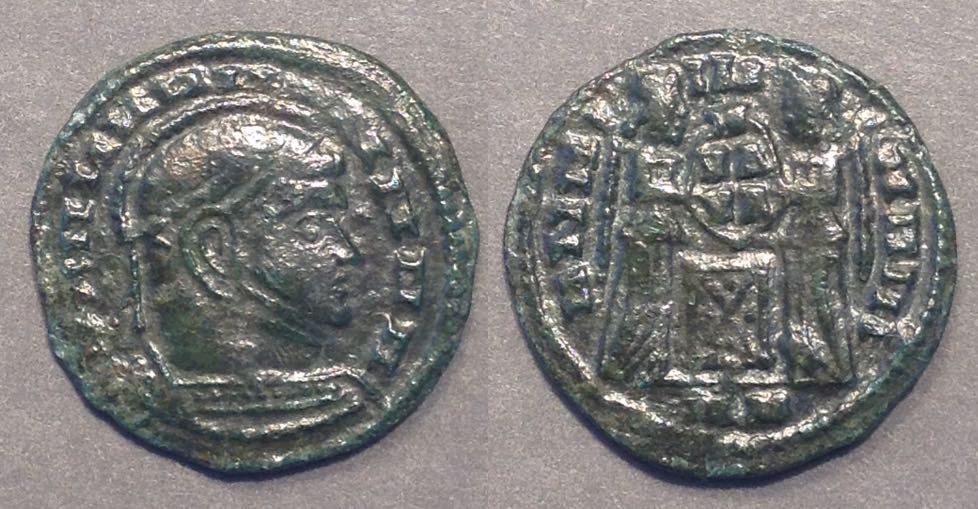
18-17 mm. 2.22 grams.
Glossy patina. Legend mostly I's, N's or H's and backward N's or H's.
well-centered.
This one may not be Balkan. I have no evidence other than its appearance.
18 mm. 2.81 grams.
Letter shapes look mostly like "I"
The mintmark almost looks like
IISIS for Siscia.
Glossy patina. Legends of mostly I's, but some look like "C" or "T".
I I I I CNST I I I I T I I ..... (some of the I's are more complex with some width and may represent other letters)
I I I C T I I I I I I ......
Mintmark resembles IISIS, for the Siscia mint.
Fairly well-engraved and struck, but with little intention of getting the letters right.

18 mm. 2.73 grams
Some Constantinian letters are properly formed: IIICOHSTIIIIT.....
/..NNNN.. more letters somewhat like N's
reversed "S" between "II" and "II" in exergue.
Comment and References. Balkan imitations were rare in the trade until the 1990s when they began flooding out from the Balkans, especially from countries formerly behind the Iron Curtain. I do not know the provenances of most of these pieces other than hearing from dealers that some came "from the Balkans" and "possibly from Slovakia." An article in Mittleilungen der Osterreichischen Numismatische Gesellschaft (41.2, 2001, pp. 27-41) by Matthias Pfisterer and Heinz Winter entitled "Eine Sammlung barbarisierter spatromischer Munzen aus Carnuntum," illustrates 37 pieces of this type in a collection of 54 imitations formed near Carnuntum, which strongly suggests at least some of them come from near Carnuntum -- not far from Vienna.
Unlike later western imitations of Constantinian other types, these are not usually smaller than the prototypes. Some are even larger!
Other references: RIC page 436f gives irregular types for Siscia. See Bruck, Die Spatromische Kupferpragung, page 75 for the altar designs and page 76 for the portraits.

20 mm. Large! 3.41 grams
large diameter. Legend of I's with large serifs.
no visible exergual mark
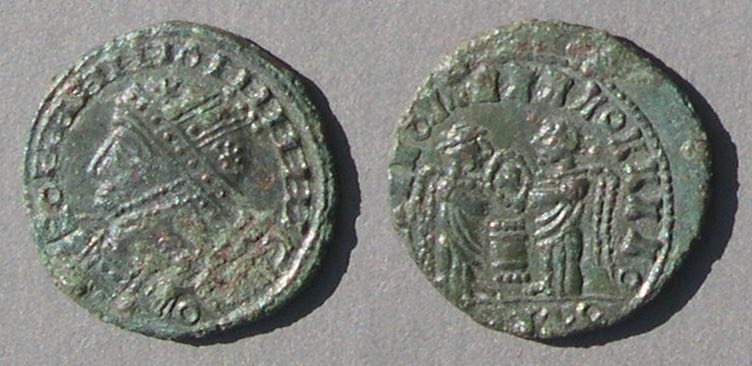
AE18. 2.77 grams.
Sharp strike, off-center on the reverse. Nice patina.
Bust left is somewhat unusual.
Stars on helmet, with three dots on the vertical central band.
 17-16 mm. 2.04 grams.
17-16 mm. 2.04 grams.
Bust left.
Very crude lettering.
These were better-than-average examples. There are very many worse Balkan "Two Victories" imitations with crude engraving and poor strikes. However, they are not usually small. Even poor examples are usually 17 mm.
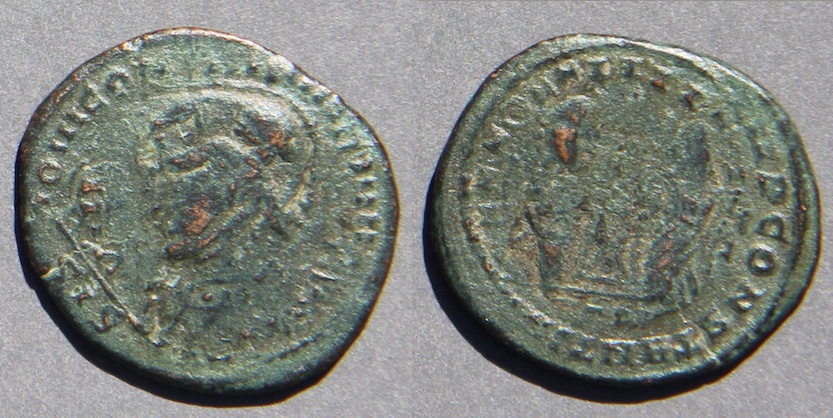 21-19 mm. 3.20 grams.
21-19 mm. 3.20 grams.
A "Two Victories" imitations (weakly) overstruck on a IOVI CONSERVATORI coin of Constantine from Siscia.
Bust left, helmeted.
The two Victoires are visible, but very weak. The associated legend on the reverse is weak but evident 10:00 to 4:00 (on the inside). The undertype is almost clearer.
Under type mintmark SIS and exergual line are visible at 7:30 on the obverse, with IOVI CON ... beginning at 9:00.
The undertype on the reverse has clear legend beginning at 2:00: IMP CONSTANTI
I wonder why a 20 mm type would need to be overstruck not long after it was issued? Perhaps the undertype was demonetized for political reasons and even an imitation would pass better than the wrong type.
Continue with imitations of Constantinian types of 330-340.
Jump to the pages on FEL TEMP REPARATIO imitations.
Return to the main page on imitations of Roman coins.
 The Constantine "Two Victories" reverse. An official example from the mint of Arles.
The Constantine "Two Victories" reverse. An official example from the mint of Arles. 19-18 mm. 2.77 grams.
19-18 mm. 2.77 grams. Constantine
Constantine Constantine
Constantine 16 mm. 1.63 grams.
16 mm. 1.63 grams. 18 mm. 3.60 grams.
18 mm. 3.60 grams.
 This is an official piece from Ticinum, the prototype for the above imitation.
This is an official piece from Ticinum, the prototype for the above imitation.
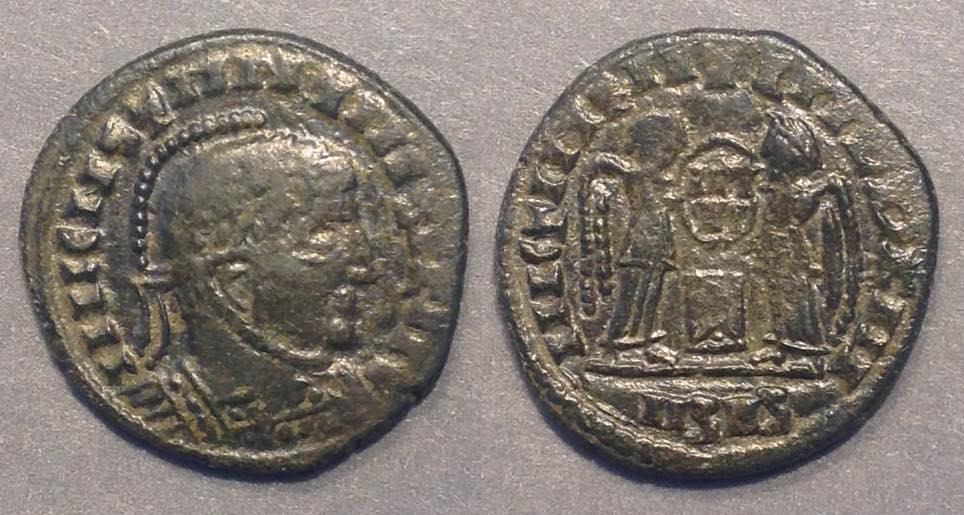



 17-16 mm. 2.04 grams.
17-16 mm. 2.04 grams. 21-19 mm. 3.20 grams.
21-19 mm. 3.20 grams.